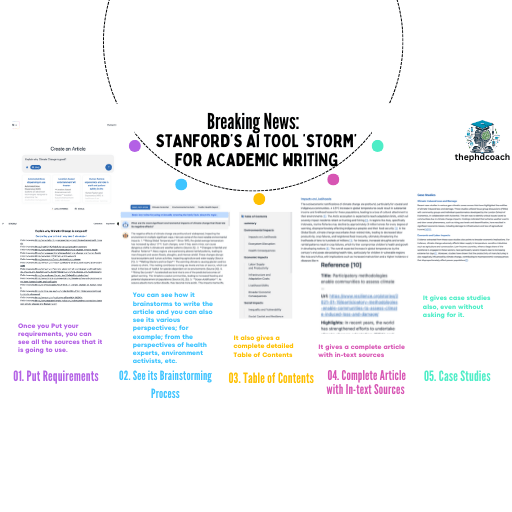
Academic writing has always been a cornerstone of knowledge dissemination, but it can be a time-intensive and overwhelming process. Enter Artificial Intelligence (AI) — a game-changer in how researchers and students approach this task. AI-powered tools have revolutionized various fields, and academic writing is no exception.
Stanford’s AI tool, STORM, stands out as a groundbreaking innovation. Designed to simplify research, enhance productivity, and deliver high-quality outputs, STORM is set to redefine how academic content is created. In this blog, we’ll explore how STORM works, its unique features, benefits, and its potential to shape the future of academic writing.
STORM, an AI-powered tool developed by Stanford, is specifically designed to make academic research and writing more accessible and efficient.
Its primary purpose is to assist writers — from students to seasoned researchers — in crafting well-structured, data-driven, and insightful academic content. STORM gathers credible sources, generates structured outlines, provides references, and even includes relevant case studies. With its user-friendly approach, STORM significantly reduces the complexities of academic writing.
STORM’s functionality is divided into three intuitive steps:
Step 1: Input Your Requirements
The process begins by entering a clear and concise topic or question. For example, if you wish to write about “Why Climate Change is not good,” simply type this query into STORM, and it will instantly begin working on your request.
Step 2: Brainstorming Perspectives
STORM goes beyond gathering information; it analyzes data from multiple perspectives. For instance, in the topic “Climate Change,” it would include perspectives from health experts, environmental activists, and policymakers. By consolidating a wide range of viewpoints, STORM ensures a balanced and comprehensive approach.
Step 3: Generating an Outline
Once data is collected, STORM organizes it into a structured Table of Contents. This feature helps users visualize their content flow, ensuring clarity and consistency. A clear academic structure ensures that no critical point is overlooked.
STORM is equipped with several innovative features that set it apart from other AI writing tools:
Automated Reference Integration
One of the most time-consuming aspects of academic writing is citing sources accurately. STORM simplifies this by generating in-text citations and a comprehensive reference list, ensuring your work adheres to academic standards.
Multidisciplinary Insights
Whether your topic relates to science, humanities, or social sciences, STORM pulls information from diverse academic fields. This multidisciplinary approach ensures your content is rich and well-rounded.
Case Studies Without Prompting
A standout feature of STORM is its ability to include relevant case studies without explicit prompting. For example, when writing about climate change, STORM might provide real-world examples of its impact on coastal communities or agricultural economies.
Time-Saving Aspects
STORM’s automated research, referencing, and outlining capabilities drastically reduce the time spent on mundane tasks, allowing users to focus on analysis and creativity.
Increased Accuracy with Credible Sources
STORM ensures accuracy by pulling information from peer-reviewed journals, academic publications, and credible websites. This guarantees the reliability of the content produced.
Enhancing Productivity for Researchers and Students
By streamlining the research and writing process, STORM allows researchers and students to handle larger workloads without compromising quality.
Accessibility for Creating Structured Content
STORM’s detailed Table of Contents and clear organization make it easy for users to create structured and professional academic content.
Environmental issues are complex, and writing about them often requires input from multiple domains. Here’s how STORM excels in this area:
This ensures that the final article is comprehensive and well-researched.
The emergence of AI tools like STORM signals a transformative shift in academic writing. By automating complex tasks, STORM allows writers to focus on their core ideas and analyses.
However, with great power comes responsibility. Ethical considerations, such as proper attribution and avoiding over-reliance on AI, are critical to maintaining academic integrity. STORM sets a strong precedent for future AI tools, combining efficiency with ethical compliance.
Stanford’s AI tool STORM is truly a game-changer in the world of academic writing. From simplifying the research process to generating structured and well-cited content, it offers an all-in-one solution for researchers and students.
By embracing tools like STORM, we can enhance productivity, accuracy, and creativity, ultimately reshaping how academic work is produced and consumed. The future of academic writing is here — and it’s powered by AI.
STORM is tailored specifically for academic writing, offering structured outlines, multidisciplinary perspectives, and automated references.
While STORM excels in academic content, its structured approach can also be applied to other types of writing, such as reports or proposals.
STORM relies on peer-reviewed journals and credible academic sources, ensuring the accuracy and reliability of its references.
Yes, STORM is designed to gather insights from a wide range of disciplines, making it suitable for nearly all fields of study.
As of now, STORM may offer limited free access, but advanced features are likely to require a subscription. Check Stanford’s official website for the latest updates.

Dr. Chopra is the founder and editor of thephdcoaches.blogs and Thephdcoaches Learn more about her here and connect with her on Instagram, Facebook and LinkedIn.
Dr. Tripti Chopra, founder of The PhD Coach, is an award-winning mentor and leader in integrating AI into academic research, with over a decade of experience guiding PhD students and researchers. Her work revolutionizes research processes, promotes sustainable writing practices, and inspires scholars to embrace technological advancements.
Copyright© 2023 Thephdcoach All rights reserved.
Leave a Comment